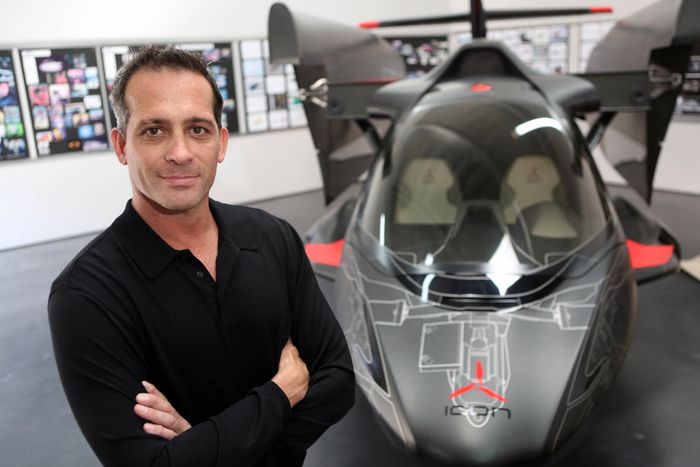Feuding investors in a California plane startup are firing off allegations against each other while the company is in the midst of a U.S. national security review, a risky tactic during the secretive process.
Icon Aircraft Inc. makes a small, amphibious plane with foldable wings that is marketed for recreational use. A group of American shareholders fell out with Chinese investors who hold a dominant stake in Icon, alleging they are improperly transferring the company’s technology to China. The Chinese investors have said in legal filings that they are pursuing a normal technology licensing agreement. They and Icon deny any improper dealing.
The Americans last year filed a lawsuit seeking to stop the alleged technology transfer. They then appealed to the Committee on Foreign Investment in the U.S., or Cfius, which reviews deals on national-security grounds, and told the panel that Icon’s technology has possible military applications.
In recent weeks, after The Wall Street Journal reported that Cfius was reviewing the deal, the sparring parties launched a series of attacks against each other.

Icon Aircraft co-founder Kirk Hawkins at the company’s offices in Los Angeles in 2013.
Photo: Ann Johansson/Corbis/Getty Images
Kirk Hawkins, a co-founder of Icon who is among the American investors fighting the Chinese investors, issued a statement to several media outlets citing a previously confidential Pentagon program looking at turning Icon’s planes into unmanned aerial vehicles. That is why, he said, the U.S. government should stop the technology transfer by the Chinese shareholders. Icon’s Chinese backer is Shanghai Pudong Science and Technology Investment Co., a government-backed firm known as PDSTI.
“It is about protecting a U.S. company from nefarious investment practices” by China, said Mr. Hawkins, who remains on Icon’s board after it ousted him as chief executive.
SHARE YOUR THOUGHTS
What action, if any, do you think U.S. national security officials should take on the Chinese investment in plane maker Icon Aircraft? Join the conversation below.
Icon, whose board is controlled by PDSTI, shot back in a statement to the Journal, saying its planes are unsuitable for military use and alleging Mr. Hawkins is motivated by self-interest, not national security concerns. Icon also released documents to the Journal, including one it says is a strategy document emailed by Mr. Hawkins in March 2020 outlining a plan to threaten to take the case to Cfius if PDSTI didn’t buy him out of Icon.
Asked about that and another document supplied by Icon, Mr. Hawkins said that he and other American shareholders came to see that PDSTI was intent on expropriating Icon’s technology. He said PDSTI offered him and other minority shareholders a buyout if they helped support a Cfius approval. They declined, he said, and decided to “contact Cfius to ask for help.” Neither Mr. Hawkins nor the lawyer representing him and the other American shareholders would elaborate.
PDSTI, in a filing in the lawsuit, makes reference to an unsuccessful attempt to resolve the dispute with the American investors. It has also said its investment saved Icon from collapse.
The public fight is unusual in the middle of a review by Cfius, said lawyers who specialize in such cases. The panel conducts its investment-screening behind closed doors and can recommend that the president block or unwind deals.
“You’re definitely playing with fire reporting a transaction to Cfius as an investor in the company,” said John Kabealo, founder of Washington, D.C., firm Kabealo Law, which isn’t involved in the Icon case.
The Cfius process has been used as a tactic by investors before, lawyers who deal with the panel said. President Donald Trump in 2018 blocked Broadcom Ltd.’s $117 billion hostile bid for Qualcomm Inc. after the wireless technology company raised national security concerns with the panel about a deal.
While companies facing scrutiny aren’t legally prohibited from discussing the process, most don’t, to avoid publicizing internal information or aggravating the panel, said the lawyers who deal with Cfius cases. Disgruntled employees, industry rivals and would-be investors cut out of a deal sometimes approach the panel to try to quash a transaction, but active investors usually don’t, the lawyers said.
“Cfius has a variety of measures to solve national security issues, and the result may be burdensome operating conditions that hurt the company’s business and your own investment value,” Mr. Kabealo said. “Plus, future investors view Cfius problems as kryptonite.”
The Treasury Department, which leads the interagency panel, declined to comment on the Icon deal. The FBI is also conducting a separate investigation into possible criminal violations related to the deal and the alleged technology transfer, as the Journal reported last month, citing documents and people familiar with the matter.

An Icon plane on display in Haikou, China, in May.
Photo: Luo Yunfei/China News Service/Getty Images
Icon was founded in 2006 by Mr. Hawkins, a former Air Force pilot, and by a former product-design lecturer at Stanford University. The company generated buzz for its sole product, the A5, a carbon-fiber plane capable of takeoffs and landings on water and land. Phil Condit, a former chief executive officer of Boeing Co. , joined the board, though he later resigned, and is still an investor.
PDSTI’s investment in Icon started out small in 2015, but by 2017, it had amassed its current nearly 47% stake, according to filings to Cfius and in the separate Delaware lawsuit by the American shareholder group, which includes Mr. Condit. Soon after, the American group said, the Chinese company began installing board members and executives and laying plans to transfer Icon’s technology to China.
As the dispute spilled out in recent weeks, Icon has painted a different picture. An Icon spokesman said allegations that PDSTI had nefariously seized control are disingenuous.
The spokesman pointed to a slide presentation that Icon says Mr. Hawkins made to PDSTI on a trip to Shanghai in 2017. The presentation urged PDSTI to pour more money into Icon to realize Mr. Hawkins’s vision of turning the company into the “Tesla / Apple of Aircraft,” according to a copy of the presentation reviewed by Journal.
One slide listed Mr. Hawkins’s preferred board candidates, among them Tesla Inc.’s Elon Musk. Mr. Musk didn’t join the board. He didn’t respond to a request for comment.
The second bullet point in Mr. Hawkins’s alleged presentation reads: “Change of Control. Future of ICON in PDSTI Hands.”
Over the following years, the American investors and executives at Icon soured on their Chinese partners, saying that they were planning to move Icon’s business to China, according to court filings by the American shareholders.
During that period, according to Icon, Mr. Hawkins emailed another Icon investor what Icon says is the March 2020 strategy document discussing a plan to get a buyout for him and other minority shareholders.
The strategy document, reviewed by the Journal, identifies the shareholders’ objective as “Force controlling shareholder to either: A) buy out the minority at fair market price” or “B) allow the company to be freely marketed and sold on the global market and relinquish control.”
Under a section called “possible negotiation strategy,” the strategy document says, “offer easy out to pay small group…OR risk the following.” Among the possible measures, it cites complaints to the White House and Cfius.
In the strategy document released by Icon, Mr. Hawkins put the likelihood Cfius would force PDSTI to divest at 50%. “Play this card last and carefully. Once initiated, can lose control of process,” the document said, adding the course of action could ultimately bankrupt Icon.
The document goes on to specify in a “Settlement Outcomes Analysis” section that “$60M $2.00/share for ~30M shares would be no brainer. All minority would take it and walk,” referring to the American shareholders.
After the Journal last month reported Icon saying that the A5 isn’t suited to military use, Mr. Hawkins sent multiple media outlets including the Journal the statement saying “there is an active program working on the militarization” of the plane. The statement didn’t elaborate on the program.
At Mr. Hawkins’s request, Mark Gamache, chief executive of defense contractor XQT LLC, issued a statement to media outlets about his company’s 2018 Defense Department contract aimed at converting Icon’s plane into an unmanned aerial vehicle, or UAV, for use by the Navy and Marine Corps.
Mr. Gamache said his team found the A5 has unique capabilities for unmanned missions, citing the plane’s wing-fold and hull designs. He said Icon and XQT have no current contract due to the continuing Cfius issues but that XQT and his Pentagon customer remain in discussions about the project.
The Icon spokesman denied that the company is involved in an “active program.” The A5, he said, “is suitable for spending a fun afternoon on a lake, not for military missions.” He said the plane “has the horsepower of a motorcycle and the capacity to carry a little over 400 pounds, including passengers, fuel, luggage, and a lunch cooler.”
He also said the A5 “cannot safely operate in water with a wave height higher than 12 inches.”
Defense Department funding went to the Navy in 2018 “to explore potential concepts of operation with the Icon aircraft,” a defense official said. The official cited the continuing investigation of Icon in declining further comment.
—Rebecca Elliott contributed to this article.
Write to Kate O’Keeffe at [email protected]
Copyright ©2022 Dow Jones & Company, Inc. All Rights Reserved. 87990cbe856818d5eddac44c7b1cdeb8








